One of the common problems, especially in the warm season, is rough heels. They spoil the appearance of the legs and cause discomfort. To correct the situation, you need to identify the causes of such changes and find out what is best to do to soften the skin and remove the stratum corneum.
Main reasons
The skin on the heels can become rough due to external and internal factors that cause deterioration in the condition of the feet.
Physiological
Often feet become rough for the following reasons:
- poor skin hydration;
- wearing shoes and clothes made from synthetic materials;
- wearing open shoes for a long time;
- tight, uncomfortable shoes;
- regular walking barefoot;
- poor foot skin care;
- using antibacterial soap;
- excessively dry indoor air;
- sudden climate change;
- strong tan;
- chlorinated water;
- drinking insufficient amounts of fluid.
Possible diseases
Such problems often signal serious illnesses:
- fungal infection;
- erythroderma;
- psoriasis;
- dermatitis;
- eczema;
- scarlet fever;
- allergic reaction;
- peeling skin syndrome;
- diabetes;
- hidden varicose veins;
- renal failure.
Hormonal changes
The deterioration of the skin of the feet is caused by hormonal fluctuations, for example, with disorders of the endocrine and reproductive systems.
Women suffer from rough heels during pregnancy, because during this period serious changes occur in the body.
Deficiency of nutrients
With an acute lack of vitamins E and A, the skin gradually dries, becomes rough, and takes on an unsightly appearance. Similar problems are caused by iron deficiency and a number of other microelements.
How to get rid of rough heels
If the question arises about how to get rid of dry heels, it is worth considering different options. There are many means that can be used to remove roughness at home in a short period of time.
Pharmacy drugs
Treatment is recommended using special ointments and creams:
- Sea wolf – an effective remedy based on extracts of seaweed and juniper. The composition contains natural oils and formic alcohol. The cream promotes hydration, wound healing, elimination of discomfort, and acceleration of regeneration processes. It is applied to the skin daily after hygiene procedures.
- Doctor. For dry skin prone to cracking. The product contains allantoin, urea, natural essential oils. The cream smoothes the epithelium, eliminates pain, stops the inflammatory process, and helps quickly tidy up the heels. The main thing is to smear your feet until the roughness completely disappears.
- Bepanten. The drug is also able to cope with dry feet. Its active component is dexpanthenol. It helps accelerate regeneration and eliminate pain. The ointment has a moisturizing and softening effect. It can be used during pregnancy and lactation.
Traditional medicine methods
You can cure your heels using baths:
- Apple cider vinegar is an effective folk remedy. Dilute 30 ml of vinegar in warm water. Immerse your feet in the resulting solution for 20 minutes. During this time, be sure to massage your feet with a soft brush, then briefly place your feet in a container of cool water.
- Soap and soda are also used to steam your feet. Add 1 tsp to warm water. liquid soap and soda, soak your feet for about a quarter of an hour. During this time, the skin softens and is easily cleansed.
- Medicinal herbs. Mint, rosemary, yarrow, chamomile, and hops are used. Based on them, a decoction is prepared, which is added to the baths.
- Sea salt. Warm milk with sea salt is added to the baths, and the feet are kept in the liquid for about half an hour.
- Wine. It is recommended to resort to this procedure once a week. Pour 0.5 liters of wine into 2 liters of water. The legs last for about 20 minutes.
- Flaxseeds. A quarter cup of flax seeds is poured with a glass of boiling water and boiled for about ten minutes. Then the broth is infused, filtered and mixed with 400 ml of peppermint infusion. The resulting liquid is diluted in 3 liters of water. Leave your feet in it for about 20 minutes.
A foot mask is effective in combating roughness.
There are several recipes for preparing this product:
- Mix one egg yolk with a pinch of starch and a few drops of lemon juice. Apply the resulting mixture to the skin after hygiene procedures. After drying, wash off the product.
- Grate the potatoes and mix with flax seeds. Pour the resulting mass with water and cook until it acquires the consistency of sour cream. Apply the product to your heels, leave for a quarter of an hour, then rinse your feet with water and treat problem areas with iodine.
- Grind the zucchini and mix with sour cream. Apply the mask to problem areas for an hour.
- Mash the strawberries and raspberries, brush the mixture onto your feet. Place a gauze bandage over it. Keep the mask on for an hour.
- Mix glycerin and ammonia in equal proportions. Rub the resulting solution into the skin overnight.
- Mash the banana. Apply the resulting mask for 20 minutes. After the specified time, rinse with water at room temperature.
Another effective therapy option is compresses.
The following means can be used:
- Hydrogen peroxide. The product is mixed with water in a ratio of 1:5. Moisten gauze in the resulting solution and apply it to the heels. After 2 hours, the compress is removed. A softening cream is applied to the skin.
- Olive oil. Rub the product onto the problem areas, then put on cotton socks. The compress is left overnight. In the morning, the skin is treated with cream.
- Flaxseed oil with oatmeal. Boil oatmeal and add oil to it. The mass is placed in plastic bags and put on the legs, fixing the compress with socks. After 2 hours, feet are washed with warm water and treated with rich cream.
Home remedies
You can restore the skin of your heels using the following folk remedies:
- Celandine. The leaves are crushed and applied to the heels. Wrap the feet in cellophane (cling film is good for this). Leave for about an hour.
- Lemon juice. It is mixed with olive oil in a 3:1 ratio. The solution is rubbed into the skin with massaging movements.
- Cabbage. The sheet is thoroughly kneaded, then applied to a rough surface. Keep it for half an hour.
- Honey. It is melted in a water bath, after which it is applied to clean, completely dry feet, be sure to wrap it in film, and put on socks. Leave it on all night. After washing off the honey, apply cream to the skin.
The fastest methods of therapy
To deal with the problem as quickly as possible, it is recommended to use the following tools:
- Apple. The fruit is crushed, wrapped in gauze, applied to the feet, secured with a sock. Leave it on all night. In the morning, cream is applied to the skin.
- Paraffin. Melt it over low heat and add a small amount of salicylic acid. When the mixture has cooled slightly, apply it with a swab to the heels. The product is applied in three layers (the next one after the previous one has dried). The feet are wrapped in a bandage. After a day, the feet are washed with soapy water. The heels are treated with pumice.
- Aspirin with lemon juice. Crush 10 tablets of the drug, mix with a small amount of water and a few drops of lemon juice. Steam your feet, apply the mixture to the affected areas, cover with foil, and put on socks. After half an hour, rinse your feet with water.
What to do if the desired effect is not achieved
If no means help to cope with the problem, you should seek help from a doctor.
Most likely, the cause of rough heels is internal disorders in the body. To normalize the condition, they need to be eliminated.
Preventive actions
To avoid such problems, you need to adhere to the following recommendations:
- exfoliate weekly;
- Apply moisturizing cream to your feet twice a day;
- drink vitamin complexes;
- lead a healthy lifestyle;
- Avoid harsh chemicals on the skin.
Conclusion
Heels become rough and peel for various reasons. Most often, the problem develops when basic foot care rules are not followed.
Normalizing the condition of the skin is quite simple. There are a lot of products that can make your skin smooth and soft. The main thing is to choose the most suitable option.
Many people face the problem of dry heels. Not only does this phenomenon cause a lot of discomfort, but also the appearance of the legs becomes unattractive. If you want to show off your soft and pink heels, then you need to provide them with gentle care.
Dry heels: cause
Girls love to show off their beautiful legs. On the street, on the beach, in the office, at home - anywhere. However, dry heels can significantly spoil the mood and force beauties to wear closed shoes. The reasons for this unpleasant phenomenon may be the following factors:
- wearing uncomfortable high-heeled shoes;
- lack of vitamins A and E, which affect the condition of the skin;
- fungal infections (in this case, in addition to dryness and cracks, there may be a change in skin color);
- improper foot care and neglect of personal hygiene rules;
- disturbances in the functioning of the endocrine system.
Should you see a doctor?
Dry heels are a fairly common problem. What to do if the problem does not go away over a long period of time? Of course, consult a doctor. The fact is that if the problem of rough skin cannot be solved with the help of cosmetic procedures, then most likely the reason lies in health problems:
- lack of vitamins in the body (both seasonal and chronic);
- fungal diseases;
- problems with the thyroid gland;
- fungus or herpes;
- eczema;
- diabetes mellitus of any type.
If you have any of the above problems, then no cosmetic procedure can cure dry heels and cracked heels. You will have to undergo complex drug treatment.
Softening procedures
Dry heels are a serious problem, but it can be solved. Constant and careful skin care is important. The main thing is that at the first signs of dryness, you need to start intensive therapy, which may include the following procedures:
- Regularly pamper your feet with herbal baths. A combination of chamomile, calendula, string and sage helps to cope with dryness and cracks. It is worth noting that such a procedure has not only a softening, but also an anti-inflammatory effect, which will be an additional prevention of fungus.
- Sea salt or regular table salt is an effective remedy against cracked and peeling skin on the heels. You need to immerse your feet in a warm, concentrated solution for a quarter of an hour. If dryness has reached a critical level or there are deep cracks, then add milk to the bath.
- Red wine has a beneficial effect on the skin. It will not only soften your heels, but also relieve fatigue. For two liters of water you need to take 2 glasses of wine (can be replaced with grape juice). In 20 minutes you won't recognize your heels.
For the effect to be noticeable and lasting, you need to complete the procedures correctly. Feet should be wiped dry and lubricated with moisturizing creams or nourishing oils. You should also wear cotton socks.
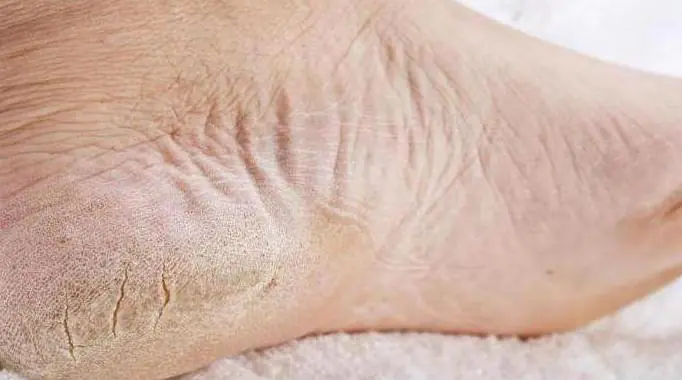
Compresses for dry heels
Due to the fact that the load on the feet and heels is quite large, they quickly lose moisture. As a result, the skin cracks and becomes rough. To revive dry heels, you need to regularly make nourishing compresses. The following recipes work best:
- Onions will help you remove the top rough layer of skin. It needs to be grated on a fine grater, then mixed with a small amount of honey and milk. Apply the resulting pulp to a bandage or gauze, apply it to the heel and wrap it with polyethylene. Put on thick socks on top and leave the compress on overnight. To eliminate the unpleasant onion smell in the morning, wash your feet well with laundry soap and be sure to apply cream.
- Honey is a real salvation for dry skin. They need to lubricate problem areas, cover with plastic and put on warm socks. It is better if the honey compress remains overnight. After you wash your feet in the morning, be sure to apply the cream.
- If the skin is not too rough, then a green apple will help you solve the problem. Rub it into a puree, wrap it in a piece of bandage or gauze and apply it to your heels. You need to secure the compress with plastic bags and socks. It's better to leave it overnight.
- Perhaps the simplest and most effective is a cabbage compress. You just need to knead a clean sheet in your hands or beat it with a rolling pin and apply it to your heel. Secure the compress with a bandage, and the next morning remove and lubricate your feet with cream.
- Celandine is a healing plant that helps to cope with many problems. If you have dry heels, you can make a healing compress at home. Chop a fresh leaf (you can beat it with a rolling pin) and apply it to the problem area. As in previous cases, you need to wrap your feet in polyethylene, put on socks and leave the product on overnight.
Pumice treatment
Many people face the problem of cracked or dry heels. What to do? Of course, treat them with pumice. Even though this is the most popular method, many people make mistakes. For example, it is wrong to treat your heels while taking a shower, or immediately after, while they are heavily steamed. It is better to do this about half an hour before swimming. The effect will be more pronounced if you lubricate your heels with a nourishing cream before treating with pumice.
Dry heels - treatment with pharmaceutical products
In the pharmacy you can find many products that are aimed at solving not only medical, but also cosmetic problems. So, if your heel is dry and cracking, then try using the following medications:
- "Five Days" is a nourishing cream with a rich composition, thanks to which your legs will simply be transformed. It has not only nutritional, but also disinfectant properties. Thus, in addition to healing cracks, fungal diseases will also be prevented.
- "Sea Wolf" is an effective budget remedy that fights a lot of problems (from the aggressive effects of water, sun or cold to a lack of vitamins and nutrients). The components of the cream promote rapid regeneration, and therefore your heels will be transformed in the shortest possible time.
- "Bepanten" is a popular remedy that helps cope with skin problems. Thanks to a component such as lanolin, the epidermis softens and cracks heal quickly.
Proven "grandmother's" remedy
Dry fives and cracked feet are a perennial problem. At the moment, in pharmacies and cosmetic stores you can find a lot of products and devices that help cope with it. What did women do in those days when only ineffective pumice was available? There is one effective recipe.
Buy a bottle of glycerin, as well as vinegar essence. This is all you need to prepare the product. The glycerin container will not be full. You need to add vinegar essence to the neck, close it tightly, and then shake vigorously.
Wash your feet well with laundry soap, steam them in a bath (you can use herbal or salt water) and rub thoroughly with a pedicure brush to remove the top layer of rough skin. Now you need to dry your skin with a towel.
Shake the bottle with glycerin and vinegar essence thoroughly, soak a cotton swab in the liquid and treat all the roughness that is on the feet, paying special attention to the heels. Next, you need to put cellophane bags and thick socks on your feet. It is best to do the procedure at night. But if you decide to do it during the day, then rest assured that the composition will be absorbed into the skin in about 40 minutes. After the procedure, you can lightly rub your heels with pumice, but this is not necessary. Wash your feet with soap and lubricate them with cream.
If your heels are in a bad state, then at first the procedure will have to be carried out daily until the skin returns to normal. After this, once a week will be enough to maintain the effect.
Preventive measures
Dry heels and cracks can cause ladies not only physical, but also aesthetic discomfort. Naturally, preventing a problem is much easier than dealing with it later. Preventive measures include the following:
- try to wear comfortable shoes, and also use special gel insoles;
- do not neglect the rules of personal hygiene - wash your feet daily using antibacterial agents;
- regularly use pumice stones, as well as scrubs (store-bought or homemade);
- before going to bed, lubricate clean feet with moisturizing creams or nourishing oils;
- Periodically take a course of vitamins A and E, and also include foods containing them (carrots, apples, grapes, etc.) in your diet.
conclusions
Dry skin on the heels, cracks - all this does not add beauty to your feet. Unfortunately, many women do not pay enough attention to this problem, which can lead to quite serious consequences. If you want to be on top in any situation, if you like to wear open shoes, and also if you want to become the queen of the beach, then your feet need regular and high-quality care. Do not neglect the rules of personal hygiene, monitor your health and nutrition, and regularly pamper your feet with herbal baths and natural peelings.
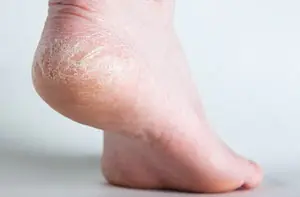
Dry skin on the heels is a nuisance that affects both women and men. She causes a lot of inconvenience. And the point here is not only that the foot looks extremely unattractive. This defect interferes with walking and can be the result of serious health problems. Therefore, it is very important to know the whole truth about dry heels, the causes and treatment of this problem.
Causes of dry heels
Many people experience keratinization of the skin on their feet and heels. This is not always related to age. The answer to the question is Why your heels are dry and cracking depends on factors such as:
- Wrong choice of shoes. This option is the most common, affecting mainly female representatives. When choosing shoes, they are guided not by convenience, but by the beauty of the model, often wearing shoes that are too tight, only to make the feet appear smaller. But if the shoes don’t fit your feet, the load on all parts of the foot increases several times. The quality of the material is also of great importance. If it is not natural, the skin hardly breathes. It becomes denser and corns form. The heels become rough, and if nothing is done, they begin to crack and hurt.

Lack of regular foot care. Spending a lot of money and time on getting their face, hands and body in order, many people don’t even remember about their feet. At best, everything is limited to a pedicure, although the skin of the feet and especially the heels requires daily attention and care. It also needs to be moisturized, cleaned and protected.- Lack of vitamins. If the body does not receive its norm of nutrients, this also affects the heels. They can crack in the absence of vitamins A, B, C and E, so you should not forget about them.
- Presence of diseases. There are a number of diseases that affect the condition of the skin of the feet. Among them are fungal infections, eczema, dermatitis, diabetes, and thyroid problems. Dry feet and heels can be caused by pregnancy, hormonal imbalance or menopause. Those suffering from diabetes should be especially careful. If not properly cared for, they may lose a foot or part of it.
Everyone should monitor their health. After all, if problems arise due to a lack of necessary vitamins or your heels become dry due to illness, even the best foot care will not help. Any disease must be treated as early as possible.
Stages of foot skin care
The skin of this part of the body, like any other, requires an integrated approach. Only in this case can you expect a quick and good result. Here are the most important parts that make up Recommended care program:
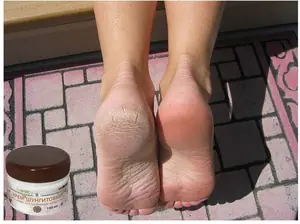
Cleansing. It all starts with him. It is useless to apply various cosmetics to dirty skin; it will not give the desired effect. You should at least wash it with soap, or you can make a special bath. Cleaning with a scrub is recommended once a week. To remove old skin, it is better to use a pumice stone or a brush;- Hydration. At this stage, all kinds of moisturizing creams are used, which are widely available in stores. If necessary, they can be easily replaced with any vegetable oil or vitamins A and E in liquid form;
- Nutrition. Ready-made store-bought products are also perfect for these purposes, or you can also use proven folk recipes.
All procedures are usually carried out in the evening shortly before bedtime, so that the skin can rest and absorb all the beneficial substances overnight.
Heel care products and tools
Helping your heels is very easy. For these purposes, they sell a lot of special products in any price category. You can also resort to folk recipes, which are also quite effective.
Pharmacy drugs
In any pharmacy today you can buy creams, sprays and ointments to improve the condition of the skin of the feet and combat rough heels.
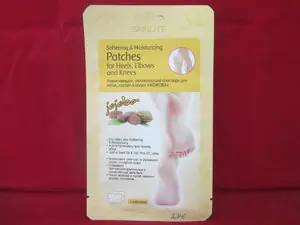
These include:
- Sea Wolf cream. It will help eliminate cracks and fight inflammation;
- ointment or cream "Panthenol". Will soften rough heels and help quickly heal fresh calluses;
- ointment "Radevit". Thanks to vitamins A, E and D, it accelerates regeneration processes and nourishes the skin. Suitable also for prevention.
A hardware pedicure, which can be done in many salons and clinics, would also be useful. This cosmetic procedure not only tidies up the nails, but also removes calluses and softens and smoothes the skin on the heels.
Folk remedies
If your heels are cracking, everyone should know what to do at home. Traditional medicine has a variety of methods and recipes that are time-tested and effective. Here are just a few of them:
- salt bath for steaming. To do this, you need to dilute 50 g of salt in warm water, soak your feet there for 15 minutes and get rid of rough skin using pumice. In advanced cases, you can do the procedure every evening, and then once a week will be enough;
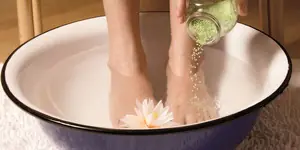
all kinds of compresses. Done at night. For them, some substance is applied to the skin of the heels, the foot is wrapped in cling film, and cotton socks are put on top. In the morning, the remnants of the compress are washed off with warm water and, if necessary, a nourishing cream is applied. For these purposes, you can use olive oil or a mixture of chopped onion with a tablespoon of milk;- rice scrub It will help to better cleanse the skin and remove dead cells. To prepare it, you need to take 1 tablespoon each of coarsely ground rice, almond oil, apple cider vinegar and honey and mix well. Pre-steamed skin is treated with the mixture, after which it is washed off and a nourishing cream is applied;
- egg mask. Prepared from egg yolk, half a teaspoon of starch and a teaspoon of lemon juice. After applying the mask to the skin of the heels, you need to wait for it to dry completely and form a crust. Then the mixture is washed off and the skin is treated with moisturizer.
To properly care for your feet, you need to have a piece of pumice or a sanding file at home. Under no circumstances should thickenings be cut off with a razor. This can damage the skin and lead to infection through the wounds. Even if this does not happen, after such removal of the skin it becomes much denser, the heel condition is only getting worse.
When processing with pumice, all movements are carried out in one direction, otherwise the skin will not become smooth. You also need to choose the force of pressure carefully. If you overdo it, you can get hurt.
After the procedure is completed, the foot must be lubricated with cream or other nourishing agent.
Preventive measures
It is always easier to prevent a problem from occurring than to fight it. This also applies to dry feet. To keep your heels soft and smooth The following rules must be observed:
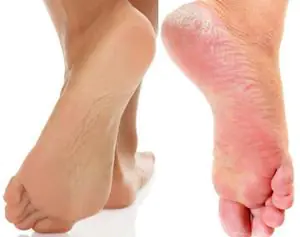
Buy and wear only high-quality shoes of the appropriate size. It is advisable to choose socks only from natural materials;- Take care of your feet regularly. Wash them daily, treat them with pumice and scrub once a week, sometimes make masks and baths, apply a nourishing and moisturizing cream in the evening;
- Include vitamins and foods rich in polyunsaturated fatty acids and beneficial microelements in your diet.
If you are still worried about such a nuisance as dry heels, you must not forget what to do at home in this case. The comprehensive use of heel skin care products will help heal them and soon forget about this inconvenience.



